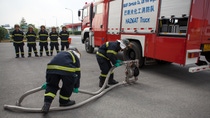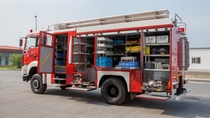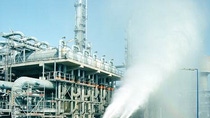Basics about Emergency Response
By: Rolf Haselhorst

People visiting BASF sites are often impressed by the company’s on- site firefighting brigades. They are often stationed in two-storeyed buildings by a site’s main entrance. Inside the massive metallic door are eye-catching red, gleaming firefighting vehicles, protective equipment and firefighters in military-green sweaters. They are often doing physical exercises, akin to a TV drama-like scene, something that is usually the extent of what most people know about emergency response.
Rolf Haselhorst, Vice President and Head of Fire Department, BASF SE, was invited to Shanghai Disaster Reduction Forum in October to share the best emergency response practices of the company. He was the sole expert among multinational chemical companies invited to the forum. In this issue of BASF information, Haselhorst introduces the ABCs of Emergency Response.
Emergency Response
Emergency response, as one of the Responsible Care Management System Codes, aims to ensure BASF makes proper preparations for any possible incidents within the product supply chain, from production to storage and transportation. BASF implements emergency response strategies in all its plants and sites worldwide. Our work involves development of fire-protection plans, regular on-site firefighting drills and employee training, in addition to firefighting simulations in case of emergency events and disasters.
Awareness
BASF Emergency Response Management System is closely bound to our companies, customers, neighborhood and communities wherever we operate. The safety and disaster prevention awareness of everyone, especially our employees, is of critical importance to the success of our programs. Every one of us is obliged to inform the related departments when accidents or potential risks are identified; this is the prerequisite for our expert team to carry out their work.
A hazard prevention system can only be effective when employees are committed to it. Therefore, safety training for ordinary employees is organized annually at BASF covering basic skills, first aid and fire extinguishing. Accident-response team members are required to take additional training in crisis management. We also conduct firefighting drills at sites on a regular basis to ensure every employee knows what to do in case of emergency.
Best team
Emergency Response Management Systems have been deployed at all major BASF sites, and related teams have established a close collaboration at the national and regional level. With the coordination of BASF Fire Department in Germany, firefighting departments worldwide have formed an extensive and highly effective network in which expertise and experiences are shared.
From fire prevention to hazard prevention, the changing role of the BASF Fire Protection Department places enormous demands on the professional qualification of employees: They must be familiar with hazard prevention and management expertise related with chemical leakage, in addition to fire extinguishing.


Collaboration
Closer collaboration between government and enterprises will contribute to better management of emergency incidents, especially in traffic accidents. As one of the major sponsors of Transport Accident Information and Emergency Response System, BASF, together with other member companies of German Chemical Industry Association, is providing chemical-related road accident rescue and consultation in 11 regions of Germany.
In China, BASF has deployed off-site emergency response systems between major sites. Once BASF product-related accidents are identified, the nearby BASF Emergency Response Teams will provide timely support once informed to reduce accident-handling time, damage and loss.
With abundant expertise and advanced rescue equipment, BASF is committed to becoming an integral part of China’s emergency response network in close cooperation with government and other players in the chemical industry.
Vehicles
BASF currently owns 40 firefighting vehicles of different purposes, including turbo extinguisher with a firing range of nearly 150 meters, remote-controlled robotic vehicles and hazmat trucks equipped with special gear.
There is a special hazmat truck stationed at the Caojing site in Shanghai. In addition to a larger body than ordinary fire extinguishers, it is unique because of the on-board special rescue equipment and supplies for chemical incidents, which are equipped in line with properties of chemicals. Besides five BASF plants in the Caojing site, it also serves the entire chemical park covering 29.4 square kilometers under direction from the fire department in Shanghai Chemical Industry Park.
Responsible Care Codes include:
- Community Awareness and Emergency Response
- Distribution Safety
- Pollution Prevention
- Process Safety
- Occupational Health and Safety
- Product Stewardship
Responsible Care
Responsible Care is the chemical industry’s global voluntary initiative under which companies work together to improve their performance in the field of environment, health and safety and to communicate with stakeholders about their products and processes.
BASF co-initiated the Responsible Care Global Charter in 2006. In 2007, we launched our own Responsible Care management system which has since formed the basis for all our environment, health and safety activities. BASF implements Responsible Care principles in daily management and continuously improve its safety performances.